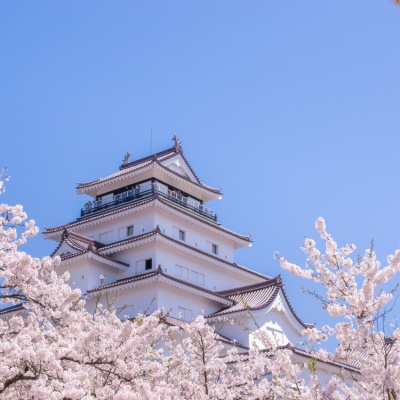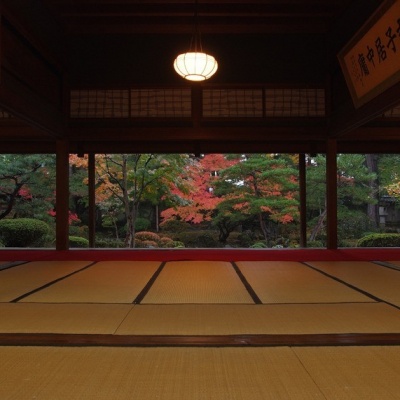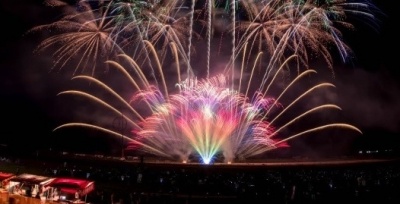3 days/2 nights based in Matsushima [Base! Tohoku]
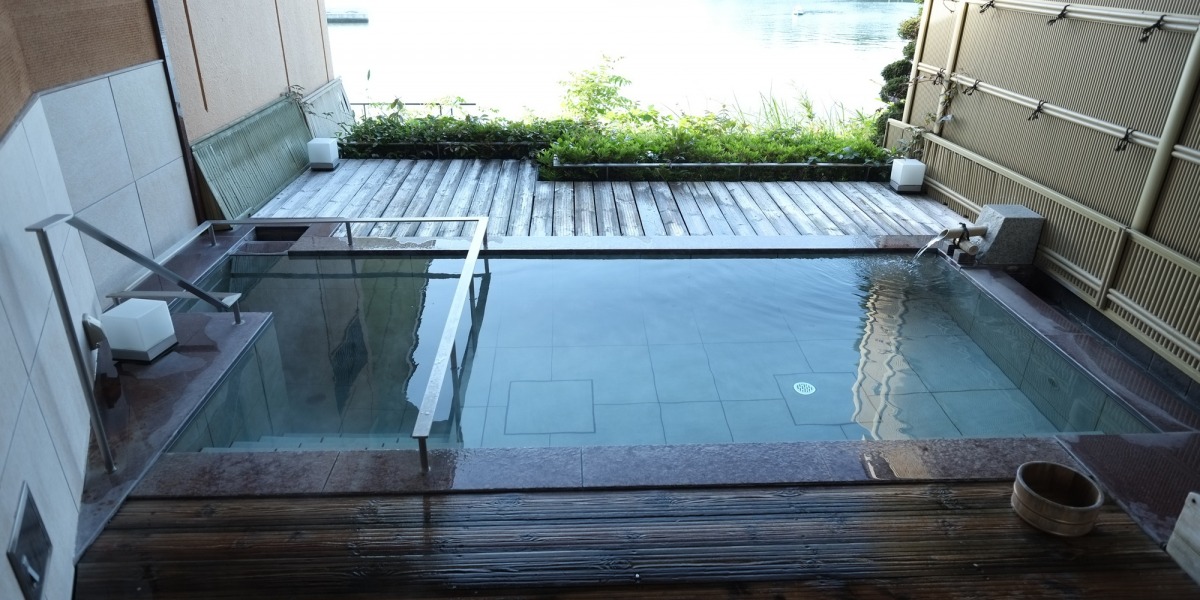
The best view of Matsushima, one of Japan's three most scenic spots with 260 islands of various sizes, can be enjoyed while soaking in a hot spring bath!
Cross the brightly painted vermillion Fukura Bridge and enjoy the soothing breeze as you gaze out at the beautiful islands of Matsushima Bay.
START
Day1
Zuiganji Temple
A temple filled with the passion and aesthetics of the celebrated feudal lord Masamune
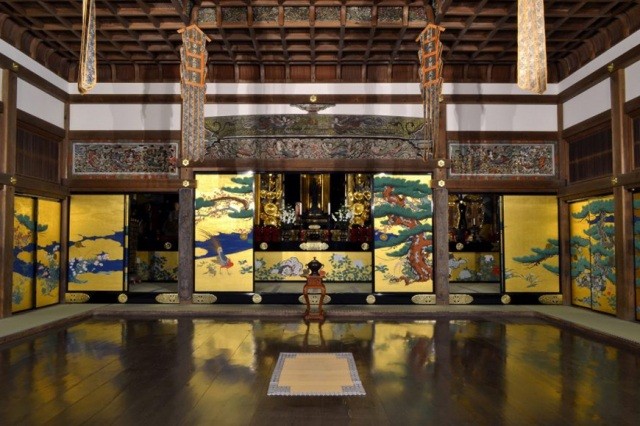
Zuiganji is the family temple of Masamune Date, a famous feudal lord of the Age of Civil Wars of the 15th and 16th centuries. The temple was originally founded in 828. After deterioration through the civil war period it was restored by Masamune Date and his aesthetic styling can be seen throughout the buildings.
The main hall and Kuri (the Zen kitchen) are designated national treasures. Inside the main hall the brilliant paintings on the sliding doors are a must see. The graceful Ume (Japanese plum) blossoms surrounding the main hall are exhilarating in spring. Visitors can also see Masamune’s aesthetics in the arabesque-pattern engravings in the Kuri.
Zuiganji offers much to see including officially designated Important Cultural Properties (Onarimon Gate, Nakamon Gate and Taiko-bei Wall), and a series of caves used for memorial services including the rock cave known as Hosshinkutsu.
The treasure house Seido-den exhibits paintings and tea ceremony items connected with the Date families along with the original paintings of the main hall’s sliding doors.
Zuiganji is one of the four temples of the Shiji Kairo Pilgrimage trail along with Chusonji and Motsuji in Hiraizumi, Iwate and Risshakuji in the mountains of Yamagata.
The renowned Entsuin temple is in the same complex and there are a number of restaurants and souvenir shops where visitors can take a break. Godaido Hall, the temple founded by Masamune previous to Zuiganji, is located nearby on the shore of Matsushima Bay.
After enjoying the breath-taking views across Matsushima Bay – known as one of Japan’s top three scenic sights – these temples are the perfect place to calm the mind and feel the spirit of the feudal Date family.
A thematic journey in the Tohoku region:Okuno Hosomichi・The History of Michinoku
The main hall and Kuri (the Zen kitchen) are designated national treasures. Inside the main hall the brilliant paintings on the sliding doors are a must see. The graceful Ume (Japanese plum) blossoms surrounding the main hall are exhilarating in spring. Visitors can also see Masamune’s aesthetics in the arabesque-pattern engravings in the Kuri.
Zuiganji offers much to see including officially designated Important Cultural Properties (Onarimon Gate, Nakamon Gate and Taiko-bei Wall), and a series of caves used for memorial services including the rock cave known as Hosshinkutsu.
The treasure house Seido-den exhibits paintings and tea ceremony items connected with the Date families along with the original paintings of the main hall’s sliding doors.
Zuiganji is one of the four temples of the Shiji Kairo Pilgrimage trail along with Chusonji and Motsuji in Hiraizumi, Iwate and Risshakuji in the mountains of Yamagata.
The renowned Entsuin temple is in the same complex and there are a number of restaurants and souvenir shops where visitors can take a break. Godaido Hall, the temple founded by Masamune previous to Zuiganji, is located nearby on the shore of Matsushima Bay.
After enjoying the breath-taking views across Matsushima Bay – known as one of Japan’s top three scenic sights – these temples are the perfect place to calm the mind and feel the spirit of the feudal Date family.
A thematic journey in the Tohoku region:Okuno Hosomichi・The History of Michinoku
Kanrantei
Enjoy a matcha (powdered green tea) experience while looking at the superb view of Matsushima Bay
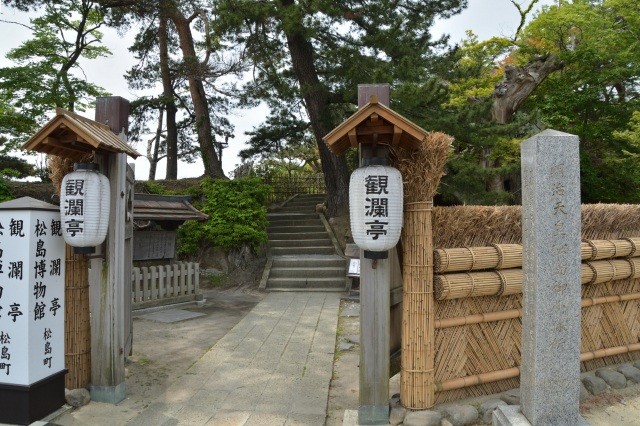
Kanrantei is a tearoom built on a small hill on the Matsushima Coast to allow you to appreciate the ripples on the water. It is said that the tearoom of Hideyoshi Toyotomi, which was once located in Fushimi Momoyama Castle, was received by Date Masamune and relocated to his Edo domain residence. It was then relocated without changing one piece of timber or stone to this area where it is possible to enjoy a superb view of Matsushima Bay by the second domain leader of Tadamune. The splendid and formal building that has been used for sightseeing and lodging by important persons has been designated as an important cultural property of Japan.
Matcha (powdered green tea) experiences are provided here at present. Why don't you try taking a break while viewing the superb sight of the beautiful Matsushima Bay in the same location as successive lords of the Date Domain? It is an adult space where you can spend your time in luxury.
Matcha (powdered green tea) experiences are provided here at present. Why don't you try taking a break while viewing the superb sight of the beautiful Matsushima Bay in the same location as successive lords of the Date Domain? It is an adult space where you can spend your time in luxury.
Godaido Temple
The symbol of Matsushima - this temple sits on its own small island with a connecting vermilion-lacquered bridge
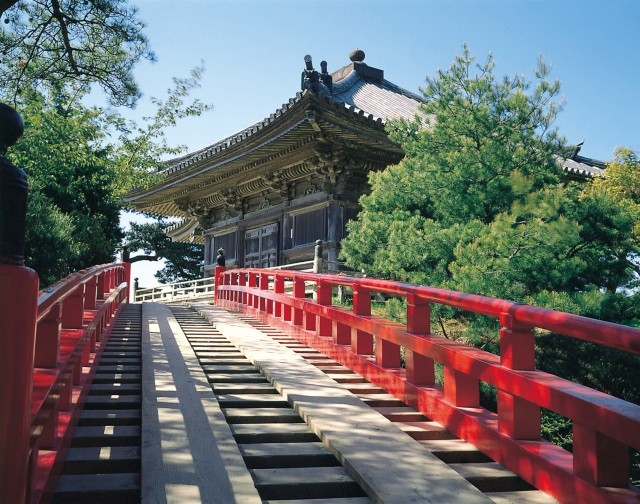
Perched on a small island jutting out into Matsushima Bay with a vermilion-lacquered bridge connecting it to the mainland, Godaido Temple is the traditional symbol of Matsushima and a scenic location from which to view the bay.
The small temple was originally founded as Bishamondo by the famous general Tamuramaro Sakanoue in 807 and took its name Godaido when the priest Ennin installed images of the Five Wisdom Kings in 828. The temple opens its doors to the public for the viewing of these images only once every 33 years.
The present temple is the one founded by the celebrated feudal lord Masamune Date. The meticulous carvings of the 12 signs of the zodiac under the eaves reflect the artistic style of the Azuchi-Momoyama period which flourished between late 16th and early 17th centuries. Godaido Temple is designated an Important Cultural Property as Tohoku’s oldest building in the style of the Azuchi-Momoyama period.
When walking across Sukashi Bridge connecting the mainland and Godaido Temple visitors can observe the water below through the wide gaps in the bridge floor. These gaps were intentionally left so that visitors would brace themselves before praying in the temple. The original bridge was in the form of a ladder, two horizontal boards were later added to allow an easier walk.
Legend has it that one night the image of Bishamonten (Vaisravana) that was enshrined by Tamuramaro Sakanoue at Bishamondo flew away to an offshore island when the priest Ennin installed the images of the Five Wisdom Kings at Bishamondo as a part of Enpukuji (Zuiganji), after which the island took its name and became Bishamon Island.
Visitors enjoy the spectacular view of the floating islands of Matsushima Bay while reflecting on this legend. Visiting the twin temples of Zuiganji and Godaigo makes for a magical Matsushima experience!
The small temple was originally founded as Bishamondo by the famous general Tamuramaro Sakanoue in 807 and took its name Godaido when the priest Ennin installed images of the Five Wisdom Kings in 828. The temple opens its doors to the public for the viewing of these images only once every 33 years.
The present temple is the one founded by the celebrated feudal lord Masamune Date. The meticulous carvings of the 12 signs of the zodiac under the eaves reflect the artistic style of the Azuchi-Momoyama period which flourished between late 16th and early 17th centuries. Godaido Temple is designated an Important Cultural Property as Tohoku’s oldest building in the style of the Azuchi-Momoyama period.
When walking across Sukashi Bridge connecting the mainland and Godaido Temple visitors can observe the water below through the wide gaps in the bridge floor. These gaps were intentionally left so that visitors would brace themselves before praying in the temple. The original bridge was in the form of a ladder, two horizontal boards were later added to allow an easier walk.
Legend has it that one night the image of Bishamonten (Vaisravana) that was enshrined by Tamuramaro Sakanoue at Bishamondo flew away to an offshore island when the priest Ennin installed the images of the Five Wisdom Kings at Bishamondo as a part of Enpukuji (Zuiganji), after which the island took its name and became Bishamon Island.
Visitors enjoy the spectacular view of the floating islands of Matsushima Bay while reflecting on this legend. Visiting the twin temples of Zuiganji and Godaigo makes for a magical Matsushima experience!
Matsushima Onsen
Indulge in the magnificent view of Matsushima, one of the Three Most Scenic Spots of Japan
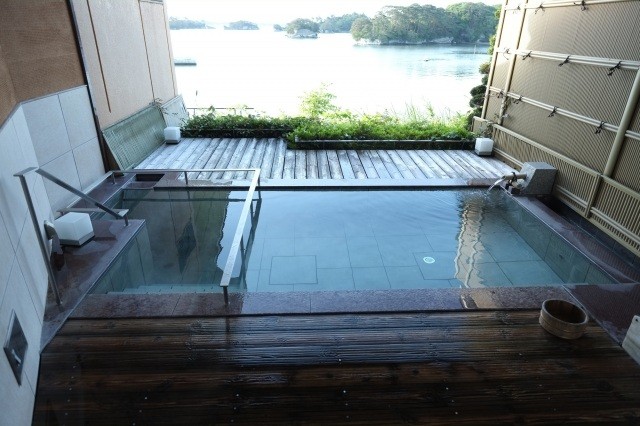
Matsushima Onsen is a new hot spring that opened in 2008 in Matsushima, one of the Three Most Scenic Spots of Japan. The silky spring hot water is known for making skin beautiful and smooth. The hot spring water is gentle and relieves the fatigue of travel. The hot spring is home to seven inns.
There is good access to Matsushima and is about 25 minutes by train from Sendai. The scenery of a moonlit night and the morning sunrise, as well as that during the daytime, is truly scenic. When poet Matsuo Basho departed to travel the narrow path in the back, he expressed his soaring heart saying, ""I have made up my mind to go see the pale moon in Matsushima."" Matsushima's moon, which has long been a repeated descriptive epithet in poetry, rises from the pine tree islands and has been referred to as a ""silver wave"" because of the heavenly light that sparkles on silver ripples in the bay. What better way to relax than to soak in a hot spring while enjoying the magnificent view of Matsushima that is unchanged since ancient times.
A thematic journey in the Tohoku region:Hot springs
There is good access to Matsushima and is about 25 minutes by train from Sendai. The scenery of a moonlit night and the morning sunrise, as well as that during the daytime, is truly scenic. When poet Matsuo Basho departed to travel the narrow path in the back, he expressed his soaring heart saying, ""I have made up my mind to go see the pale moon in Matsushima."" Matsushima's moon, which has long been a repeated descriptive epithet in poetry, rises from the pine tree islands and has been referred to as a ""silver wave"" because of the heavenly light that sparkles on silver ripples in the bay. What better way to relax than to soak in a hot spring while enjoying the magnificent view of Matsushima that is unchanged since ancient times.
A thematic journey in the Tohoku region:Hot springs
Day2
Fukuurajima
Cross a red bridge and take a stroll around the island while admiring the scenery of Matsushima
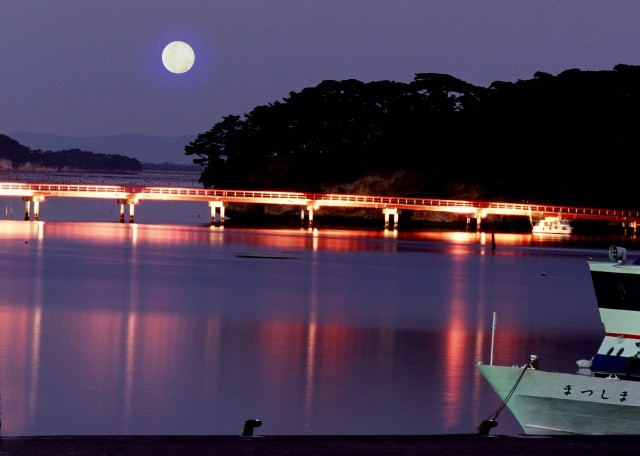
Fukuurajima is connected to the mainland by Fukuura-bashi Bridge (also known as Deai (Encounter) Bridge) painted brilliant vermillion with a total length of 252 meters. It costs 200 yen for adults and 100 yen for children to cross the bridge. Nevertheless, it is worth crossing! You will arrive at Fukuurajima by crossing over the bridge while a pleasant breeze blows. There are approximately 250 species of plants (e.g., red pine, cedar and fir) growing on the island. There is a nature park set up with a trail, so you can have lots of fun taking a walk. It also has a tea house and other facilities.
You can take photographs brimming with the beauty of nature against a backdrop of beautiful islands in the bay as seen from Fukuurajima. It is photogenic. In addition, the color of the sea changes depending on the time you visit. The views of the sea in the morning, daytime and early evening each have their charms.
You will also find deeply historic sites here. These include kaizuka (shell mounds) and Benzaiten (goddess of arts and wisdom) properties.
You can take photographs brimming with the beauty of nature against a backdrop of beautiful islands in the bay as seen from Fukuurajima. It is photogenic. In addition, the color of the sea changes depending on the time you visit. The views of the sea in the morning, daytime and early evening each have their charms.
You will also find deeply historic sites here. These include kaizuka (shell mounds) and Benzaiten (goddess of arts and wisdom) properties.
Matsushima Bay and the four best viewing locations (Shitaikan)
Unbeatable locations to enjoy views across Matsushima Bay
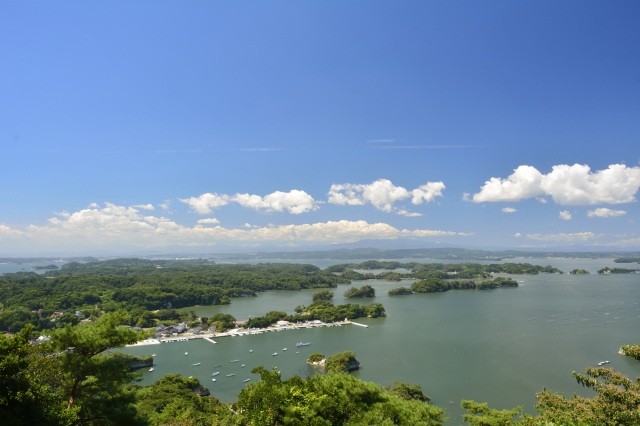
Along with Amanohashidate in Kyoto and Miyajima in Hiroshima, Matsushima Bay is known as one of Japan’s top three scenic views. The bay is dotted with some 260 islands of various sizes. The best locations for a panoramic view of these islands are known as the Shitaikan and each location has a nickname describing its view.
The Sokan (magnificent view) from Mount Otakamori at 105.8m above sea level offers a view of Matsushima Bay from the east. Visitors can enjoy a 360° panoramic view of Matsushima Bay while feeling as if they were at their own private water villa. The view includes the Sagakei cliffs and the distant Zao mountain range.
The Reikan (elegant view) from Mount Tomiyama at 116.8m above sea level is the highest viewpoint of the Shitaikan. Visitors can enjoy a graceful view of Matsushima Bay from the peaceful garden of Daigyoji Temple enshrining Tomiyama Kannon at the top of the mountain.
The Ikan (grand view) from Mount Tamon at 55.6m above sea level offers views of the bay and Shiogama port with its ships gracefully entering and departing.
The Yukan (spiritual view) from Ogidani highland at 55.8m above sea level provides a panoramic view of Matsushima Bay and the beautiful fan-shaped inlet spanning to the bay before you. The Yukan is also known for its stunning display of autumn leaves.
After enjoying the magnificent view from the Shitaikan, a pleasure boat ride through the islands is another popular attraction. Feeding the flock of seagulls from the boat will be one of the many local memories that will remain with you!
The Sokan (magnificent view) from Mount Otakamori at 105.8m above sea level offers a view of Matsushima Bay from the east. Visitors can enjoy a 360° panoramic view of Matsushima Bay while feeling as if they were at their own private water villa. The view includes the Sagakei cliffs and the distant Zao mountain range.
The Reikan (elegant view) from Mount Tomiyama at 116.8m above sea level is the highest viewpoint of the Shitaikan. Visitors can enjoy a graceful view of Matsushima Bay from the peaceful garden of Daigyoji Temple enshrining Tomiyama Kannon at the top of the mountain.
The Ikan (grand view) from Mount Tamon at 55.6m above sea level offers views of the bay and Shiogama port with its ships gracefully entering and departing.
The Yukan (spiritual view) from Ogidani highland at 55.8m above sea level provides a panoramic view of Matsushima Bay and the beautiful fan-shaped inlet spanning to the bay before you. The Yukan is also known for its stunning display of autumn leaves.
After enjoying the magnificent view from the Shitaikan, a pleasure boat ride through the islands is another popular attraction. Feeding the flock of seagulls from the boat will be one of the many local memories that will remain with you!
Matsushima Fish Market
A market with a large range of fresh seafood - including tuna and oysters!
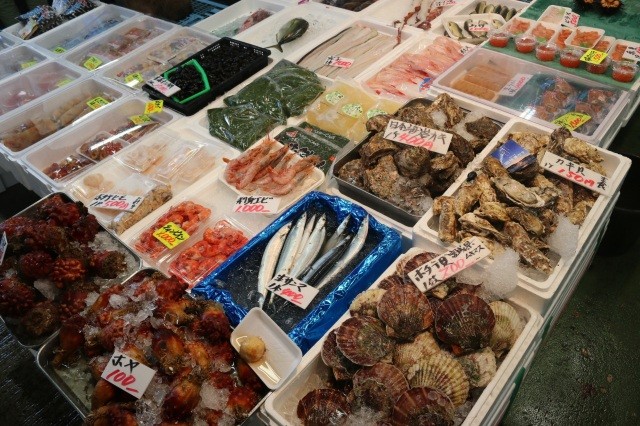
Matsushima Fish Market is about 10 minutes on foot from Matsushima-Kaigan Station on the Senseki Line. It is located in the center of a town that bustles with tourists from Japan and overseas. You will find a rich lineup of fresh marine products - approximately 1,500 kinds - in the shops. In addition, tuna dissection shows and events to serve freshly caught marine products are held in great numbers every month.
There is a strong image of oysters when we think of Matsushima. Nevertheless, Matsushima Fish Market, which is operated by a tuna fishing boat charterer, sells tuna with excellent freshness that have been quickly frozen once being caught on a boat.
There is a sushi area and flame-broiled food area on the first floor. You can eat freshly flame-broiled marine products that are piping hot here. The second floor is home to a dining space with more than 120 seats. You can eat fresh seafood here. Furthermore, there is a lineup of rare products that are hard to obtain elsewhere (e.g., delicacies, canned food, nori seaweed and sasakama (bamboo leaf-shaped fish paste). You will find it exciting to just look at these products. This makes it a fun sales area. There is an oysters cooked in the shell house in the parking lot. The all-you-can-eat piping hot and bouncing oysters are very popular.
There is a strong image of oysters when we think of Matsushima. Nevertheless, Matsushima Fish Market, which is operated by a tuna fishing boat charterer, sells tuna with excellent freshness that have been quickly frozen once being caught on a boat.
There is a sushi area and flame-broiled food area on the first floor. You can eat freshly flame-broiled marine products that are piping hot here. The second floor is home to a dining space with more than 120 seats. You can eat fresh seafood here. Furthermore, there is a lineup of rare products that are hard to obtain elsewhere (e.g., delicacies, canned food, nori seaweed and sasakama (bamboo leaf-shaped fish paste). You will find it exciting to just look at these products. This makes it a fun sales area. There is an oysters cooked in the shell house in the parking lot. The all-you-can-eat piping hot and bouncing oysters are very popular.
Matsushima Onsen
Indulge in the magnificent view of Matsushima, one of the Three Most Scenic Spots of Japan

Matsushima Onsen is a new hot spring that opened in 2008 in Matsushima, one of the Three Most Scenic Spots of Japan. The silky spring hot water is known for making skin beautiful and smooth. The hot spring water is gentle and relieves the fatigue of travel. The hot spring is home to seven inns.
There is good access to Matsushima and is about 25 minutes by train from Sendai. The scenery of a moonlit night and the morning sunrise, as well as that during the daytime, is truly scenic. When poet Matsuo Basho departed to travel the narrow path in the back, he expressed his soaring heart saying, ""I have made up my mind to go see the pale moon in Matsushima."" Matsushima's moon, which has long been a repeated descriptive epithet in poetry, rises from the pine tree islands and has been referred to as a ""silver wave"" because of the heavenly light that sparkles on silver ripples in the bay. What better way to relax than to soak in a hot spring while enjoying the magnificent view of Matsushima that is unchanged since ancient times.
A thematic journey in the Tohoku region:Hot springs
There is good access to Matsushima and is about 25 minutes by train from Sendai. The scenery of a moonlit night and the morning sunrise, as well as that during the daytime, is truly scenic. When poet Matsuo Basho departed to travel the narrow path in the back, he expressed his soaring heart saying, ""I have made up my mind to go see the pale moon in Matsushima."" Matsushima's moon, which has long been a repeated descriptive epithet in poetry, rises from the pine tree islands and has been referred to as a ""silver wave"" because of the heavenly light that sparkles on silver ripples in the bay. What better way to relax than to soak in a hot spring while enjoying the magnificent view of Matsushima that is unchanged since ancient times.
A thematic journey in the Tohoku region:Hot springs
Day3
Marine Gate Shiogama
Gateway to sightseeing in Matsushima
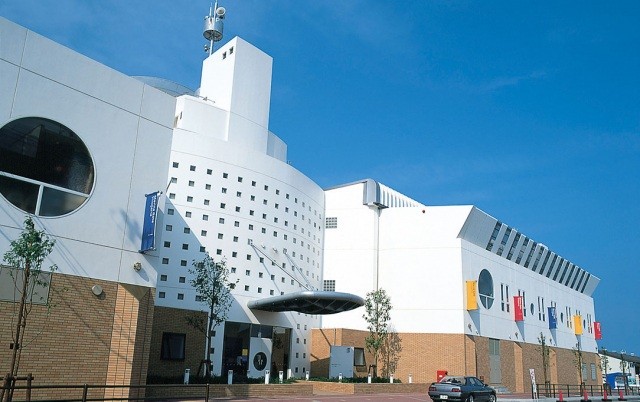
Passenger Terminal. It is the departure and arrival point for steamships that travel between Shiogama and the Urato Islands, remote islands off of Shiogama, and it is also where sightseeing boats go to and from Matsushima, one of Japan's three most scenic spots, making it the gateway to sightseeing in Matsushima.
The nearest station is Hon-Shiogama Station on the JR Senseki Line. It is a 10-minute walk along the deck from the station to Marine Gate Shiogama, and you can enjoy the sea breeze. The elevated walkway Marine Deck Shiogama connects from in front of Aeon Town, a shopping center adjacent to the station.
The first floor of the building has souvenir stores selling freshly baked sasa-kamaboko (bamboo-shaped fish cake) and other local specialties. The second floor is home to sushi, Italian, Chinese, local cuisine, and other restaurants, while the rooftop has an observation deck. There is plenty to do while waiting for your ship to depart.
This area also attracts a large number of spectators during the Shiogama Minato Festival, one of the three major boat festivals in Japan.
The nearest station is Hon-Shiogama Station on the JR Senseki Line. It is a 10-minute walk along the deck from the station to Marine Gate Shiogama, and you can enjoy the sea breeze. The elevated walkway Marine Deck Shiogama connects from in front of Aeon Town, a shopping center adjacent to the station.
The first floor of the building has souvenir stores selling freshly baked sasa-kamaboko (bamboo-shaped fish cake) and other local specialties. The second floor is home to sushi, Italian, Chinese, local cuisine, and other restaurants, while the rooftop has an observation deck. There is plenty to do while waiting for your ship to depart.
This area also attracts a large number of spectators during the Shiogama Minato Festival, one of the three major boat festivals in Japan.
Sendai Castle ruins
An impregnable and famous castle built on Mt Aoba.
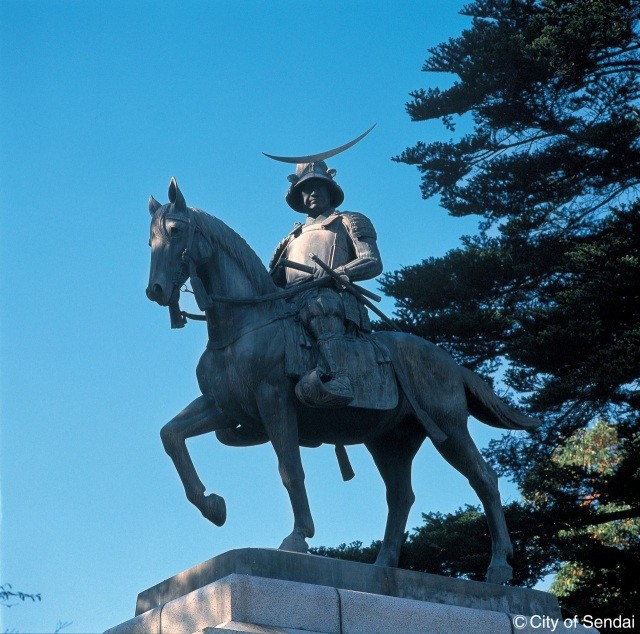
Sendai Castle (Aoba Castle) was the residence of Date 620,000 goku. The castle was built at an elevation of 130 m above sea level, with cliffs to the east and south. It is said that the castle did not have a castle tower to avoid the warnings of Shogun Tokugawa Ieyasu. Unfortunately, the castle is now gone, and the reconstructed side turrets are a reminder of bygone days. If you stand in front of the statue of Masamune Masamune's cavalryman, you can view the city of Sendai from the same vantage point as Masamune, who was ambitious to conquer the whole country.
At the Aoba Castle Museum and Exhibition Hall, visitors can view computer-generated images of a reconstruction of Aoba Castle. In the summer of 2003, Aoba Castle was designated as a National Historic Site.
The area around the ruins of the castle is Aobayama Park, and from the ruins of the castle's main citadel, you can enjoy a panoramic view of Sendai City and the Pacific Ocean. In front of the bronze statue of Bansui Doi, an automatic performance of "The Moon over the Deserted Castle" is played every 30 minutes from 9:00 to 18:00. From the castle tower, visitors can enjoy the night view of Sendai, a city of one million.
At the Aoba Castle Museum and Exhibition Hall, visitors can view computer-generated images of a reconstruction of Aoba Castle. In the summer of 2003, Aoba Castle was designated as a National Historic Site.
The area around the ruins of the castle is Aobayama Park, and from the ruins of the castle's main citadel, you can enjoy a panoramic view of Sendai City and the Pacific Ocean. In front of the bronze statue of Bansui Doi, an automatic performance of "The Moon over the Deserted Castle" is played every 30 minutes from 9:00 to 18:00. From the castle tower, visitors can enjoy the night view of Sendai, a city of one million.
GOAL
